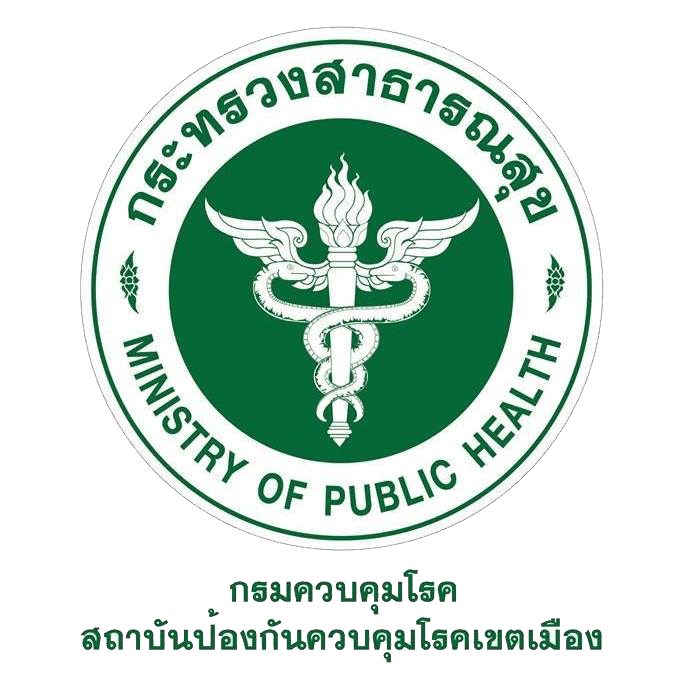ความสัมพันธ์ของการเปลี่ยนแปลงปริมาณฝุ่นละอองที่มีขนาดไม่เกิน 2.5 ไมครอน (PM 2.5) กับผู้ป่วยโรคทางเดินหายใจ บริเวณกรุงเทพมหานคร
Main Article Content
บทคัดย่อ
ปัญหามลพิษทางอากาศโดยเฉพาะฝุ่นละอองที่มีขนาดไม่เกิน 2.5 ไมครอน (PM 2.5) เป็นปัญหาหลักที่ส่งผลกระทบต่อสุขภาพอนามัยของมนุษย์ โดยเฉพาะระบบทางเดินหายใจ การศึกษาครั้งนี้มีวัตถุประสงค์เพื่อศึกษาปริมาณฝุ่นละอองขนาด PM2.5 บริเวณกรุงเทพมหานครที่มีผลต่อจำนวนผู้ป่วยโรคทางเดินหายใจ โดยศึกษาค่าเฉลี่ย PM2.5 แบบรายปี รายเดือน และรายฤดูกาลในบริเวณพื้นที่กรุงเทพมหานคร จำนวน 11 ปี (พ.ศ.2554-2564) และค่าเฉลี่ยจำนวนผู้ป่วยโรคทางเดินหายใจรายเดือนและรายฤดูกาล จากการศึกษาค่าเฉลี่ย PM 2.5 รายปี ระหว่างปี พ.ศ. 2554-2564 พบว่าปี พ.ศ. 2556 มีค่าเฉลี่ยฝุ่น PM 2.5 มีค่าสูงสุด (35.11 ไมโครกรัมต่อลูกบาศก์เมตร) ส่วนปี พ.ศ. 2560 มีค่าเฉลี่ยต่ำที่สุด (20.33 ไมโครกรัมต่อลูกบาศก์เมตร) โดยเดือนมกราคม มีค่าเฉลี่ยมากที่สุด (44.22 ไมโครกรัมต่อลูกบาศก์เมตร) ส่วนในเดือนสิงหาคมจะมีค่าเฉลี่ยน้อยที่สุด (18.52 ไมโครกรัมต่อลูกบาศก์เมตร) ส่วนค่าเฉลี่ยรายฤดูกาล พบว่าฤดูหนาวมีค่าเฉลี่ยมากที่สุด (29.51 ไมโครกรัมต่อลูกบาศก์เมตร) ในขณะที่ฤดูฝนมีค่าเฉลี่ยต่ำสุด (21.86 ไมโครกรัมต่อลูกบาศก์เมตร) ส่วนผู้ป่วยโรคทางเดินหายใจพบว่าฤดูหนาวมีจำนวนผู้ป่วยโรคทางเดินหายใจมากที่สุด และฤดูฝนมีจำนวนผู้ป่วยน้อยที่สุด โดยค่าความสัมพันธ์ระหว่างฝุ่น PM2.5 กับผู้ป่วยโรคทางเดินหายใจ แสดงให้เห็นว่าฝุ่นละออง PM2.5 กับโรคทางเดินหายใจมีความสัมพันธ์กันน้อย (ค่าสัมประสิทธิ์ของการตัดสินใจ (R²) ปี2563 และ 2564 เท่ากับ 0.2069 และ 0.0047 ตามลำดับ)
Article Details

อนุญาตภายใต้เงื่อนไข Creative Commons Attribution-NonCommercial-NoDerivatives 4.0 International License.
บทความที่พิมพ์ในวารสารสถาบันป้องกันควบคุมโรคเขตเมือง ถือว่าเป็นผลงานวิชาการ งานวิจัยและวิเคราะห์ ตลอดจนเป็นความเห็นส่วนตัวของผู้เขียนเอง ไม่ใช่ความเห็นของสถาบันป้องกันควบคุมโรคเขตเมือง หรือคณะบรรณาธิการแต่ประการใด ผู้เขียนจำต้องรับผิดชอบต่อบทความของตน
เอกสารอ้างอิง
Otti VI, Ogbuagu FU. Environmental Health Effects of Exposure to Air Pollution in Industrialized Areas. Civil and Environmental Research. 2014; 6(5): 80-84.
Chirasophon S, Pochanart P. The Long-term Characteristics of PM10and PM2.5 in Bangkok,
Thailand. Asian Journal of Atmospheric Environment. 2014; 14(1): 73-83.
กฤษฎาธร ทรัพอุไรรัตน์, กุลธิดา บรรจงศิริ. ความสัมพันธ์เชิงปริมาณของฝุ่นละอองขนาดไม่เกิน 10 ไมครอน (PM10) และฝุ่นละอองขนาดไม่เกิน 2.5 ไมครอน (PM2.5) ของแต่ละภูมิภาคและฤดูกาล. วารสารวิทยาศาสตร์และเทคโนโลยีหัวเฉียวเฉลิมพระเกียรติ. 2563; 6(1): 94-103.
สุธารัตน์ หมื่นมี, ศุษิระ บุตรดี. การประเมินความเสี่ยงด้านสุขภาพจากการได้รับฝุ่น PM2.5จากพื้นที่อุตสาหกรรมใน อำเภอปลวกแดง จังหวัดระยอง. วารสารนเรศวรพะเยา. 2564; 14(3): 95-110.
บรรจบ ชุณหสวัสดิกุล, พยงค์ วณิเกียรติ, อัมพร กรอบทอง,กมล ไชยสิทธิ์. ผลต่อสุขภาพของฝุ่นละอองในอากาศขนาดไม่เกิน 2.5 ไมครอน กลไกก่อให้เกิดโรคและการรักษาด้วยการแพทย์ทางเลือก. วารสารการแพทย์แผนไทยและการแพทย์ทางเลือก. 2563; 18(1): 187-202.
ธัญญา สุพรประดิษฐ์ชัย. คุณลักษณะประชากรพฤติกรรมในการป้องกันตนเองและการประเมินสุขภาพตนเองของประชากรในพื้นที่ที่มีความเข้มข้นของฝุ่น PM2.5 สูงในกรุงเทพมหานคร. วรสารวิชาการมหาวิทยาลัยนอร์ทกรุงเทพ. 2564; 10(1): 1-18.
Glencross D.A, Ho TR, Camiña N, Hawrylowicz CM, Pfeffer PE. Air Pollution and Its Effects on the Immune System. Free Radic Biol Med 2020; 151: 56-68.
Goossens J, Jonckheere AC, Dupont LJ, Bullens DMA. Air Pollution and the Airways: Lessons from a Century of Human Urbanization. Atmosphere 2021; 12(7): 1-22.
Losacco C, Perillo A. Particulate Matter Air Pollution and Respiratory Impact on Humans and Animals. Environ Sci Pollut Res Int. 2018; 25(34): 33901–33910.
Jerrett M, Burnett RT, Ma R, Pope C.A III, Krewski D, Newbold KB, et al. Spatial analysis of air pollution and mortality in Los Angeles. Epidemiology. 2005; 16(6): 727-36.
Laden F, Schwartz J, Speizer FE, Dockery DW. Reduction in fine particulate air pollution and mortality: Extended follow-up of the Harvard Six Cities study. Am J Respir Crit Care Med. 2006; 173(6): 667-72.
Krewski D, Jerrett M, Burnett RT, Ma R, Hughes E, Shi Y, et al. Extended follow-up and spatial analysis of the American Cancer Society study linking particulate air pollution and mortality. Res Rep Health Eff Inst. 2009; 140: 115-36.
Beelen R, Hoek G, Brandt P.AVD, Goldbohm RA, Fischer P, Schouten LJ, et al. Long-term exposure to traffic-related air pollution and lung cancer risk. Epidemiology. 2008; 19(5): 702-10.
Naess O, Nafstad P, Aamodt G, Claussen B, Rosland P. Relation between concentration of air pollution and cause-specific mortality: Four-year exposures to nitrogen dioxide and particulate matter pollutants in 470 neighborhoods in Oslo, Norway. American Journal of Epidemiology. 2007; 165(4): 435-43.
Tecer LH, Alagha O, Karaca F, Tuncel G, Eldes N. Particulate matter (PM2.5, PM2.5-10 and PM10) children’s hospital admissions for asthma and respiratory diseases: A bidirectional case-crossover study. Journal of Toxicology and Environmental Health. 2008; 71(8): 512–20
Mirabelli MC, Vaidyanathan A, Flanders WD, Qin X, Garbe P. Outdoor PM2.5, Ambient Air Temperature, and Asthma Symptoms in the Past 14 Days among Adults with Active Asthma. Environmental Health Perspectives. 2016; 124(12): 1882-1890.
Wang X, Xu Z, Su H, Ho HC, Song Y, Zhend H, et al. Ambient particulate matter (PM1, PM2.5, PM10) and childhood pneumonia: The smaller particle, the greater short-term impact?. Science of the total environment. 2021; 772: 1-9.
กรมควบคุมมลพิษ. สถานการณ์สิ่งแวดล้อมของประเทศไทย 2564. จดหมายข่าวพิทักษ์สิ่งแวดล้อม 2565; 2(3): 1-7.
วรญา ยุวะสุ. รูปแบบภูมิทัศน์ขนาดเล็กเพื่อลดปัญหาฝุ่นละอองขนาดไม่เกิน 2.5 ไมครอน [ วิทยานิพนธ์ปริญญาวิทยาศาสตรมหาบัณฑิต]. เชียงใหม่: มหาวิทยาลัยแม่โจ้; 2564.


